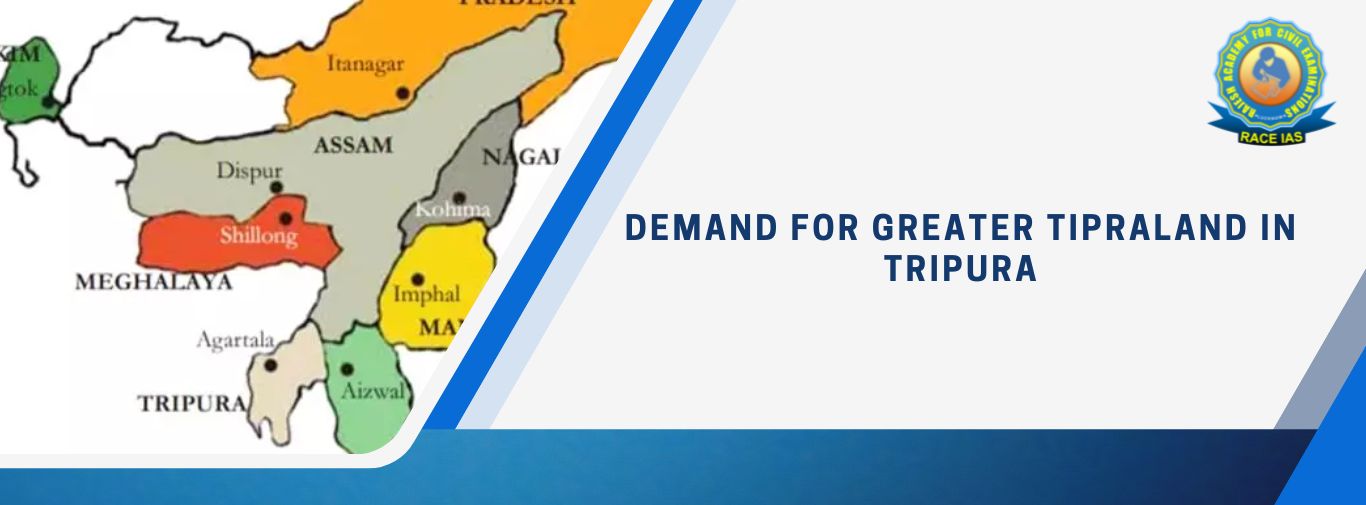
DEMAND FOR GREATER TIPRALAND IN TRIPURA
DEMAND FOR GREATER TIPRALAND IN TRIPURA I Race Ias : Best IAS Coaching in lucknow I Current Affairs
DEMAND FOR GREATER TIPRALAND IN TRIPURA
Why in News:
- In recent times, a political party in Tripura, Tipra Indigenous Progressive Regional Alliance Motha, has been demanding Greater Tipperaland.
- Tipra Motha said through a vision document that it seeks a permanent solution to uphold the rights of the indigenous people of Tripura as per the Constitution of India.
About Greater Tipraland:
- Greater Tipraland is one of the main ideological demands of Tipra Motha.
- The Indigenous People's Front of Tripura, formed in the year 2000, was the first to demand Tipraland.
- Greater Tipperaland is an extension of the demand of Tipperaland as a separate state for the tribals of Tripura by the Indigenous People's Front of Tripura.
- The proposed model of a separate state covers every tribal person living in an indigenous area or village outside the 'Tripura Tribal Areas Autonomous District Council'.
- It also includes Tripuris living in the Indian states of Assam, Mizoram, Nagaland etc.
- The Tripuris, also known as Tipra, Tiprasa, Twipra, are the original ethnic group of Tripura.
- Tripuris are the major tribes of the state. They constitute more than 50% of the population of Tripura state as per 2011 census.
- These tribes also include people living in Bandarban, Chittagong, Khagrachari and other border areas of neighboring Bangladesh.
About Tipra Motha Party Political Party:
- This political party was founded by Pradyot Bikram Manikya Deb Burma.
- The main demand of this party is "Greater Tipperaland". Tipraland is a proposed area for Tripuris.
- They are now a part of Tripura state. They demand 68% of the state of Tripura. Along with this, this party also wants to connect the Tripuris living outside the region.
Reasons for the demand for Greater Tiparaland:
- During the decade of 1941, the population ratio of both tribals and non-tribals in Tripura was about 50:50.
- However, in the 1950s the population of these tribes declined to less than 37% due to the influx of more and more refugees from East Pakistan.
- During 1950 and 1952, more than 1.5 lakh refugees entered Tripura for permanent residence.
- Due to the growing differences between the original tribals and non-tribals with the coming of these refugees, the conflict escalated till the year 1980 and finally this conflict took the form of armed insurgency.
- At present the demand for this new state has taken the form of sovereignty and independence.
Tripura Tribal Areas Autonomous District Council:
- The Tripura Tribal Areas Autonomous District Council was formed in the year 1985 under the Sixth Schedule of the Constitution.
- Its objective is to ensure development of areas belonging to Tripuri communities.
- To safeguard the rights of the people of tribal communities and their cultural heritage.
- This council has both legislative and executive powers.
- About two-thirds of the total geographical area of the state comes under this council.
- The Tripura Tribal Areas Autonomous District Council receives only two per cent of the state's budget, even though it houses 40% of the state's population.
- The reason for this discrimination with the Tripura Tribal Areas Autonomous District Council is also the reason for the growing demand for Greater Tipraland.
Constitutional Features:
- Tripuri wants a separate state as per Articles 2 and 3 of the Constitution.
- Article 2 says that the territories acquired or under the control of the Government of India shall be converted into a separate state.
- Article 3 explains the rules and procedures for creating a new state. It also talks about changing the boundaries of the existing state.
- 6th Schedule: The 6th Schedule of the Constitution protects the rights of tribes in the tribal areas of Assam, Meghalaya, Mizoram and Tripura. This schedule was added to the Constitution through the 22nd Constitutional Amendment Act, 1969. This schedule empowers Parliament to establish an autonomous state for certain tribal areas and a local legislature or council of ministers or both.
About Tripura State:
- This state was formed on 21 January 1972. It is the third smallest state of India situated on the north-eastern border. Agartala is the capital of Tripura.
- Its area is 10,4 91 sq km. Bangladesh is situated in its north, west and south while Assam and Mizoram are situated in the east.
- In the year 2011, the population of this state was about 36 lakh 71 thousand.
- Bengali and Tripuri are the main languages of this state.
- The Legislature of this state is unicameral with 60 assembly seats.
- Here 1 seat for Rajya Sabha and 2 seats for Lok Sabha are fixed.
Conclusion:
- Due to the separatist and divisive policies of regional political parties in India, in the last few decades caste conflicts have increased, as well as the demand for new states has also increased. All this is not in the interest of the country, so the central government needs to implement comprehensive and effective policies to maintain the continunity of unity, integrity and sovereignty of the country.
-----------------------------------------------------
Mains Exam Question:
During the last few years, there has been a growing demand for the creation of a Greater Tipperaland state in Tripura. Mention the challenges faced by the central government in the formation of new states.